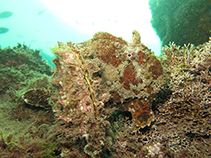| Family: |
Antennariidae (Frogfishes) |
| Max. size: |
28.5 cm SL (male/unsexed) |
| Environment: |
demersal; brackish; marine; depth range 10 - 80 m, |
| Distribution: |
Eastern Atlantic: Morocco to Angola (Ref. 7394, 57225). |
| Diagnosis: |
Dorsal spines (total): 3-3; Dorsal soft rays (total): 11-14; Anal spines: 0-0; Anal soft rays: 6-10. Diagnosis: body short and globose; mouth large with many small, villiform teeth; skin rough, covered with bifurcate dermal spinules; pectoral-fin lobes attached to sides of body; illicium at most as long as second dorsal-fin spine; large, conspicuous ocellus below dorsal fin on either side of body (Ref. 57225).
Description: filaments of lure distinctly shorter than shaft of illicium; illicium 9.0-13.6% of SL and almost as long as second dorsal-fin spine which is curved backwards and attains 8.0-13.5% of SL; third dorsal-fin spine also curved backwards, attaining 17.5-25.9% of SL; eye diameter 3.9-6.3% of SL (Ref. 57225).
Coloration: highly variable (beige, brown, blackish, yellowish or pinkish) in preserved specimens, with body and fins brown-spotted except on inner side of paired fins; dark ocellus surrounded by bright ring located on either side of body below dorsal-fin base; there may be up to seven irregular-shaped dark spots behind and below insertion points of pectoral-fin lobes; also, up to six round spots on anal fin (Ref. 57225). |
| Biology: |
Neritic species (Ref. 10959). Occurs in marine or brackish water (Ref. 57225). |
| IUCN Red List Status: |
Least Concern (LC); Date assessed: 09 May 2013 Ref. (130435)
|
| Threat to humans: |
harmless |
Source and more info: www.fishbase.org. For personal, classroom, and other internal use only. Not for publication.

